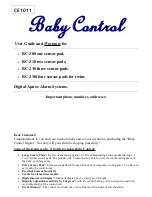
EYE-LCD7000 / 8200
28
8.4 How to minimize the Danger of Image Retention
)
Reduce Ambient Temperature
The ambient temperature and therefore the temperature inside the LCD display
plays a decisive role for the appearance of image retention.
The risk of image retention increases the higher the surrounding temperature is.
If possible, the ambient temperature should not exceed 35°C. It is also possible to
ensure that the ventilation slots of the display are not covered or full of dust.
half brightness
full brightness
)
Reduce the Display Brightness by 50 %
Most applications do not require the highest brightness of the displays. The
displays can be used with half of the brightness in the same efficient way and do
still provide perfect visibility of their content.
Half of the brightness of our LCDs is still more than what you can expect from a
plasma screen. In addition to that, the reduced brightness enlarges the life-time of
the display, saves a lot of energy and allows later readjustments of the brightness
level.
)
Stand-by-Mode and Switching Off the Device
If the display is not in operation it should always be switched to stand-by mode,
or even better, completely switched off. Operating the device even without
images displayed shortens the life-time of the display and is an unnecessary waste
of energy. Switching off the display or turning it to Stand-by-mode for about six to
eight hours per day enlarges the life-time of the product decisively and reduces
the risk of image retention.
)
Power Off, Screen Saver, or Power Save Mode
3
Turn the power off for 4 hours after 20 hours in use
3
Turn the power off for 2 hours after 12 hours in use
3
Set the Monitor to power off with the PC Display Properties Power
Scheme.
3
Use a Screen saver if possible - Screen saver in one color or a moving
image is recommended.
)
Screen Saver for Static Images
Certain fields of application depend on the display of static image contents. If
possible you should activate a screen saver on the computer for these signals if
they do not have to be surveyed as long as they do not change their content.
To avoid image retention
the displayed contents/
signals should be
changed in size and
position from time to
time.
)
Scaling of the Input Signals
Since they might also cause image retention you should avoid black image
borders on the display. Signals that do not have the same native aspect ratio
as the display should always be scaled up to use the entire screen area. This
guarantees that the entire display surface is used and no black borders can occur.
For example, a 4:3 image signal should be scaled up to 16:9 format to fill the
complete screen.
















































